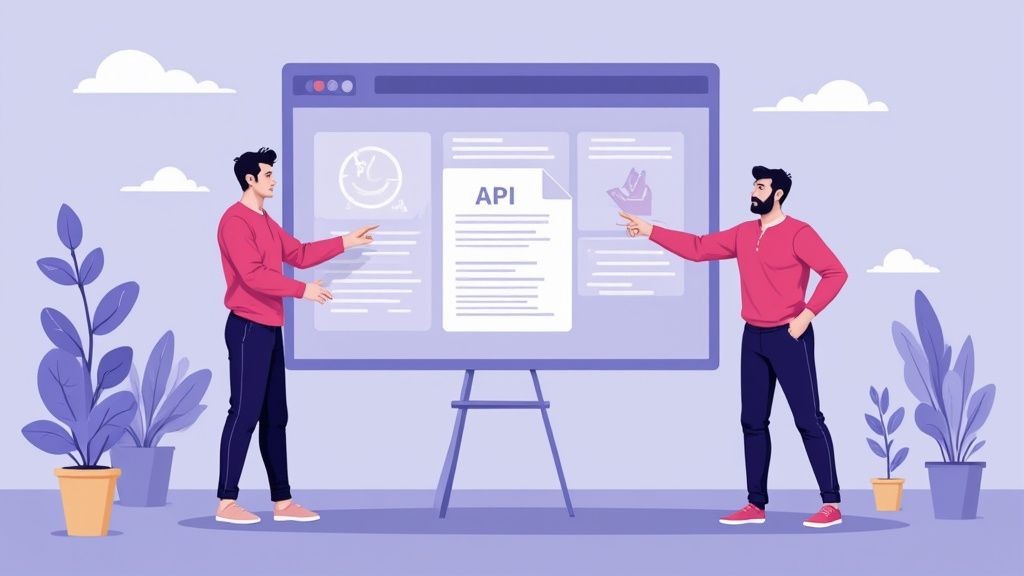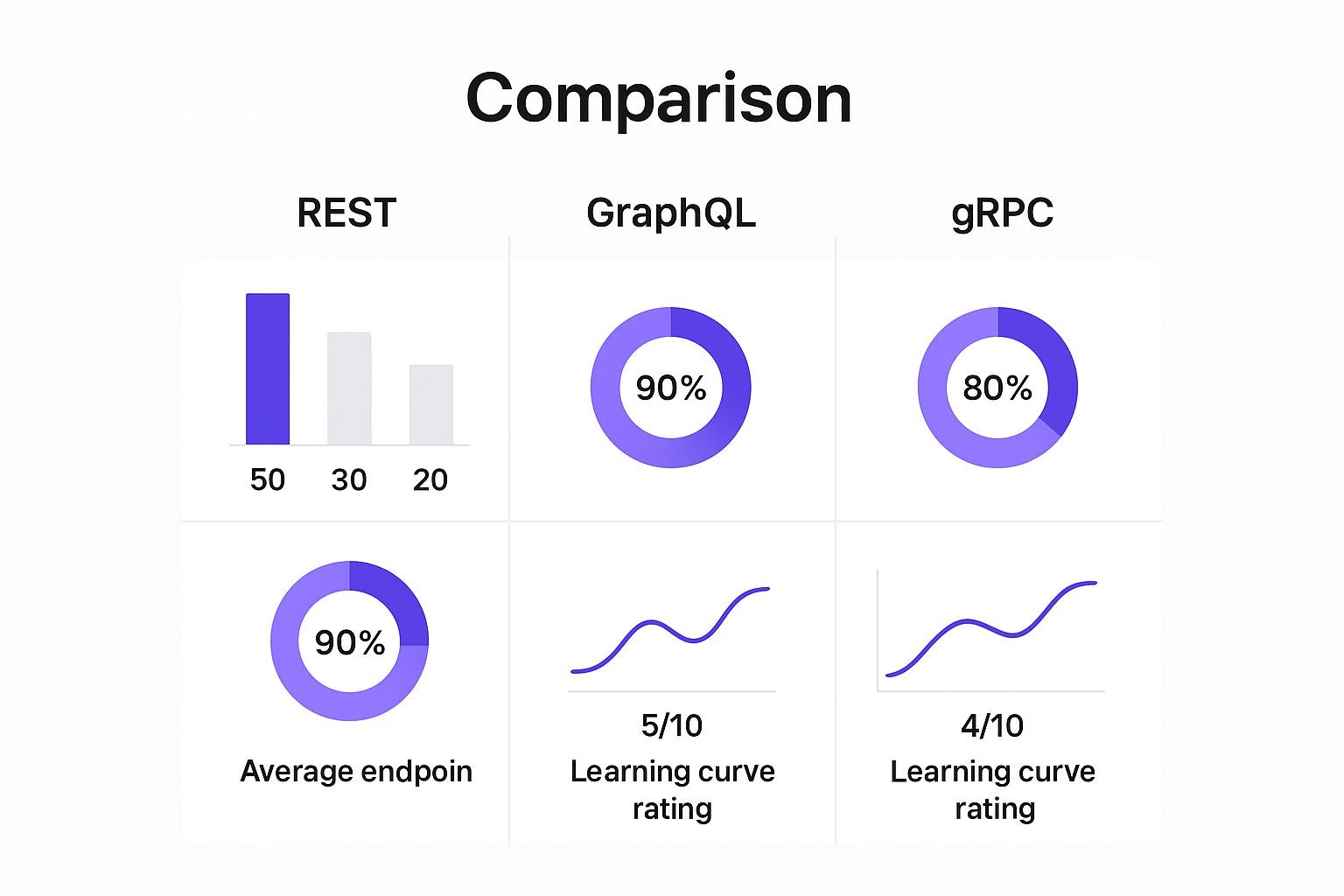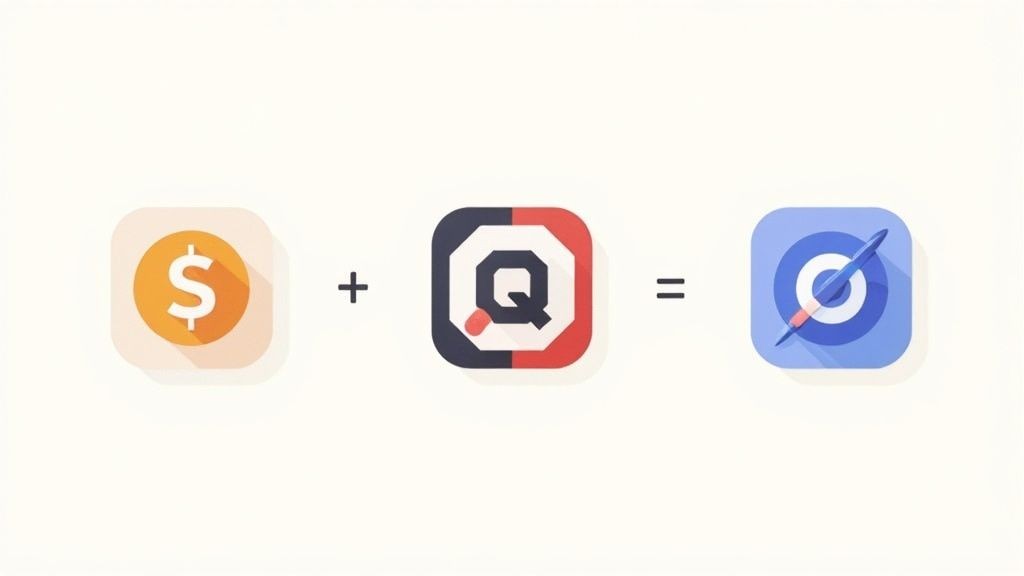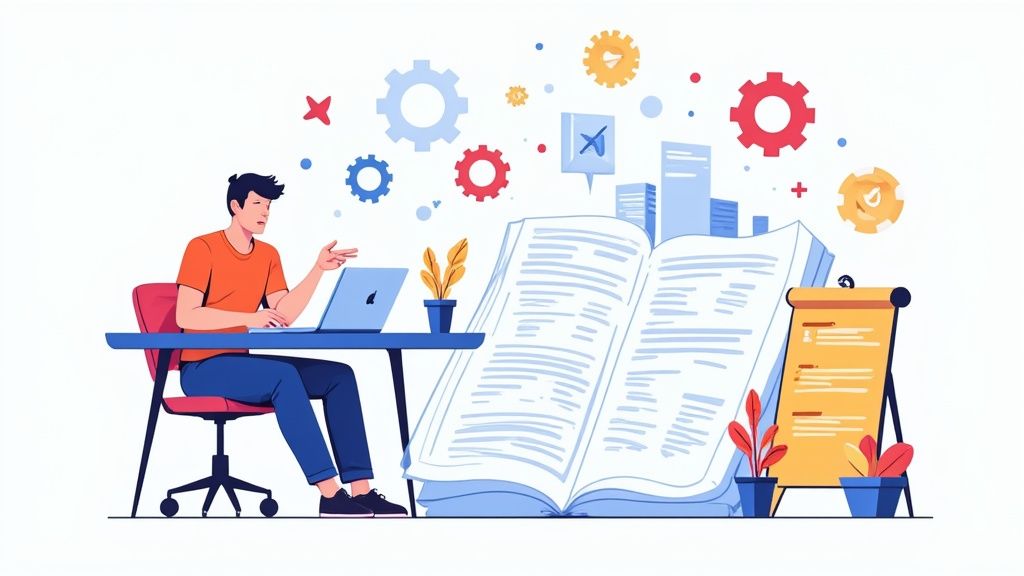API documentation is the official instruction manual for an Application Programming Interface (API). It's the guide that spells out what an API does, how to use it, and what you can expect from it when you hook it into your own software. Without it, developers are left flying blind.
What is API Documentation, Really?
Ever tried putting together a complex LEGO set without the instruction booklet? That’s what it feels like to use an API without solid documentation. You're left with a frustrating mess of trial and error that wastes a ton of time and, more often than not, leads to something that’s completely broken.
Let's try another angle. Think of an API as a restaurant's kitchen, ready to cook specific dishes on demand. You, the developer, are the customer ordering from your table.
API documentation is the menu. It tells you exactly what dishes (functions or endpoints) are available, what ingredients they require (parameters), and how to properly place your order (make a request).
Without that menu, you'd have no idea what to ask for or how to ask for it. This guide is the crucial difference between a smooth integration and a complete disaster, making sure different software systems can talk to each other without a hitch.
Before we go deeper, here’s a quick breakdown of what good documentation does for developers.
Core Functions of API Documentation at a Glance
This table sums up the primary roles that API documentation plays throughout the development process. It's more than just a list of commands; it's a foundational tool.
| Function | What It Provides | Benefit for Developers |
|---|---|---|
| Onboarding | Step-by-step guides, "Getting Started" sections, and authentication info. | Drastically shortens the time it takes for a new developer to make their first successful API call. |
| Reference | A comprehensive directory of all endpoints, parameters, and potential error codes. | Gives experienced users a quick, reliable way to look up specifics without digging through code. |
| Troubleshooting | Clear explanations of error messages and common issues. | Helps developers debug issues faster and get their applications working correctly. |
| Adoption | A polished, intuitive, and helpful developer experience. | Makes the API more appealing to use, encouraging more developers to choose it over competitors. |
As you can see, documentation touches every part of the developer's journey, from their first line of code to ongoing maintenance.
The Real Purpose of Clear Instructions
At its heart, the main goal of API documentation is to be the single source of truth for anyone using the API. It’s there to eliminate confusion and answer critical questions before they turn into problems. Good documentation isn't just a nice-to-have; it's a core feature that serves a few key purposes:
- Fast Onboarding: It helps new developers get up and running with an API in minutes, not days. This massively lowers the barrier to entry.
- A Reliable Reference: It’s the go-to resource for seasoned developers who need to double-check a specific endpoint, an error code, or an authentication method.
- Driving Adoption: A great developer experience is a competitive advantage. High-quality documentation makes an API more attractive and encourages developers to pick it over other options.
In the end, documentation isn't a technical afterthought. It's a fundamental tool for success that gives developers the power to build incredible things without unnecessary frustration.
Why Quality API Documentation Is Non-Negotiable

A powerful API without clear documentation is like a sports car with no keys - it's packed with potential but ultimately goes nowhere. Quality documentation is the bridge that connects your API's power to real-world applications. Its importance isn't just a technical detail; it's a core part of business strategy.
Good docs dramatically shorten the learning curve for developers. This means they can integrate your API faster, with fewer frustrated support tickets bogging down your team. When developers can figure things out on their own, they get back to building what matters. In short, quality documentation is one of the best ways to boost developer productivity.
The Business Case for Better Docs
Great documentation creates a fantastic developer experience (DX). In a crowded market, a smooth DX can be the one thing that makes developers choose your API over a competitor's. It acts as a single source of truth, removing guesswork and helping teams build with confidence and consistency.
This reliability pays off - literally. As more companies go digital, the demand for well-documented APIs is exploding. The global API management market, which includes documentation tools, was valued at roughly USD 6.85 billion in 2025. It’s expected to rocket to around USD 32.48 billion by 2032, showing just how much the industry is investing in getting this right.
Ultimately, investing in what is API documentation is investing in your product's usability and adoption. It empowers developers, reduces internal costs, and accelerates innovation.
For any business, this means a stronger position in the market and a faster route to hitting your goals. When developers succeed with your API, your business succeeds right alongside them. It’s that fundamental.
The Building Blocks of Great API Documentation
Think of great API documentation less like a dense textbook and more like a perfectly organized toolkit. A good mechanic knows exactly where every wrench and screwdriver is; a developer needs the same logical layout to build something without endless frustration. So, let's break down the essential components that every developer looks for.
The first thing anyone needs is the key to the front door: Authentication. This part has to be crystal clear. It should walk a developer step-by-step through getting an API key or an OAuth token, complete with code snippets they can just copy and paste. If they can't get in, they can't use your API. Simple as that.
Next up is the heart and soul of the docs: the Endpoint Reference. This is the detailed catalog of every single action the API can perform.
Dissecting API Endpoints
Each endpoint needs its own dedicated page that explains exactly what it does. It must lay out the HTTP method (like GET for fetching data or POST for creating it), the specific URL path, and any parameters the developer needs to send along. For a truly top-tier experience, every endpoint needs:
- Request Examples: Show precisely how to structure a call, from the headers to the request body. Bonus points for providing examples in a few different programming languages.
- Response Examples: Show what a successful response looks like and, just as importantly, what an unsuccessful one looks like. This helps developers anticipate the data they'll get back and build their error handling.
- Error Codes: A comprehensive list of potential error codes (like 404 Not Found or 401 Unauthorized) is an absolute lifesaver. Explain what each one means and, ideally, how to fix the issue.
The table below gives you a side-by-side look at how a well-documented endpoint provides far more value and clarity than a poorly documented one.
Comparing Poor vs. Excellent Endpoint Documentation
| Element | Poor Documentation Example | Excellent Documentation Example |
|---|---|---|
| Description | Gets user data. | Retrieves the profile information for a specific user by their unique ID. |
| HTTP Method & Path | GET /user | GET /v2/users/{userId} |
| Parameters | id | userId (Path, integer) - Required. The unique identifier for the user. |
| Request Example | None provided. | curl -X GET "https://api.example.com/v2/users/12345" -H "Authorization: Bearer <YOUR_API_KEY>" |
| Success Response | Shows a JSON blob with no context. | Code 200 OK: Includes a full JSON response with explanations for each field (e.g., firstName, email, creationDate). |
| Error Response | "Error" | Code 404 Not Found: {"error": "User not found"} Code 401 Unauthorized: {"error": "Invalid API Key"} |
As you can see, the "Excellent" column doesn't just list information; it guides the developer, preventing confusion and saving them hours of guesswork.
This infographic breaks down some key documentation metrics for different API architectures, showing what the landscape looks like.

The data suggests that while REST APIs often have more endpoints, their documentation tends to be more thorough, which significantly lowers the learning curve for developers trying to get started.
Finally, any solid documentation will clearly outline its Rate Limits and Usage Policies. This tells developers how many requests they can make within a certain time frame so they don't accidentally get their access blocked. These aren't just minor details - they're fundamental to building a reliable integration.
For more tips on connecting services without a hitch, check out our guide on API integration best practices.
Best Practices for Developer-Friendly Documentation
 Creating documentation that developers actually enjoy using is about more than just listing technical specs. It’s a complete mindset shift. You're not just writing a manual; you're crafting a user-centric guide that gets ahead of their questions and helps them get a win, fast.
Creating documentation that developers actually enjoy using is about more than just listing technical specs. It’s a complete mindset shift. You're not just writing a manual; you're crafting a user-centric guide that gets ahead of their questions and helps them get a win, fast.
The first step? Write for a human being.
That means using clear, simple language and dropping the jargon. If a developer has to open a new tab to Google a term you used, you’ve already thrown a wrench in their workflow. The goal is a smooth, frictionless experience from start to finish.
Great documentation is proactive, not reactive. It should answer questions before a developer even thinks to ask them, guiding them intuitively toward their goal.
One of the most powerful tools for this is a dedicated "Getting Started" guide. This section needs to be laser-focused on one thing: giving a developer the absolute fastest path to making their first successful API call. We're talking minutes, not hours.
Creating Consistency and Clarity
Once a developer is up and running, consistency is everything. The style, structure, and tone across your documentation should feel familiar and predictable. A developer shouldn’t have to relearn how to find information just because they’re looking at a different endpoint.
To take your docs from just "good enough" to truly exceptional, you need to bake in a few key practices:
- Interactive Examples: Let developers play. A sandbox or a "Try it now" feature that lets them make real API calls right in the docs is invaluable. Nothing beats learning by doing.
- Stay in Sync: Your documentation must be a perfect mirror of your API. Any update - no matter how small - has to be reflected in the docs immediately. Out-of-date information is a one-way ticket to developer frustration.
- Maintain a Changelog: A clear, easy-to-read changelog isn't optional. It keeps developers in the loop on updates, deprecations, and new features so they’re never caught off guard.
Just like clear documentation prevents API integration headaches, clear communication can prevent missed appointments. You can dive deeper into effective communication strategies in our guide to writing effective event email reminders.
At the end of the day, focusing on these practices turns your documentation into a resource that empowers developers, builds trust, and frankly, makes your API a pleasure to work with.
Theory is great, but nothing beats seeing how the pros do it. When you look at the API documentation from industry leaders, you get a clear benchmark for what works and what doesn't. These companies don't just treat their APIs as a feature; they treat them as a core product, and their documentation shows it.
Take Stripe’s API documentation, for example. It's legendary for a reason. They pioneered the iconic two-panel layout that so many others have tried to copy. On the left, you get the explanations. On the right, you get interactive code examples.
This design is brilliant because it lets you read a concept and immediately see it in action. The code on the right even updates dynamically as you toggle different options or switch programming languages. It’s a hands-on learning experience, not just a wall of text.
It's Not Just About the Reference
Another standout is Twilio. Their API reference is perfectly solid, but where they really shine is their huge library of tutorials and guides for specific use cases. Instead of just listing endpoints, their documentation is built around solving actual problems, like "How to send an SMS" or "How to build a video chat app."
This problem-first approach is a game-changer. It helps developers get something working fast instead of forcing them to piece together a solution from scratch. They're focused on practical results, which empowers developers and gets projects off the ground much quicker.
Both Stripe and Twilio get it: API documentation isn't just a technical checklist. It's one of the most powerful tools you have for driving adoption and, ultimately, making money.
Their success is a big part of why the API management market is absolutely booming. We're seeing it grow from $5.76 billion in 2023 to a projected $49.95 billion by 2032. You can dig into more data on the growing API management market to see the full picture, but the takeaway is clear.
Great documentation is the foundation of this growth, turning a complex API into a product that people are excited to use and pay for. By learning from these examples, you can create docs that don't just inform developers - they inspire them to build.
Frequently Asked Questions About API Documentation
To wrap things up, let's tackle a few common questions that pop up when people talk about API documentation. Getting these details straight will give you a much clearer picture of how this all works in the real world.
One of the first things that trips people up is the difference between documentation and specifications. It's a subtle distinction, but a really important one.
What Is the Difference Between an API Specification and Documentation
While they're joined at the hip, they play two very different roles.
An API specification (think OpenAPI/Swagger) is the formal, machine-readable contract for your API. It's the technical blueprint - a rigid definition of every endpoint, all the parameters you can use, and exactly what kind of response to expect.
API documentation, on the other hand, is the human-friendly guide built around that blueprint. It adds the missing context, tutorials, and real-world examples that a spec just doesn't have. The best documentation almost always starts with a specification but gets layered with storytelling and use cases to create a great developer experience.
Who Is Responsible for Writing API Documentation
Pulling together solid documentation is almost always a team sport. The developers who built the API are usually the first ones to put pen to paper (or fingers to keyboard), since they have the deepest knowledge of how everything works.
But the best documentation comes from collaboration. Dedicated technical writers often step in to polish the content, making sure it’s clear, consistent, and easy for someone on the outside to understand. Product managers also play a part by outlining key use cases, ensuring the docs line up with what the product is trying to achieve for its users.
What Are the Most Common Documentation Tools
There's a whole ecosystem of tools out there. For developers who want to spin up interactive docs right from a specification, tools like Swagger UI and Redoc are incredibly popular. They do an awesome job of turning a formal spec into a browsable reference.
For a more all-in-one solution, platforms like Stoplight, ReadMe, and Postman offer richer features, like collaborative editing and even built-in API testing.
And for teams who love a "docs-as-code" workflow, static site generators like Docusaurus or MkDocs are a fantastic choice. They build beautiful documentation sites from simple Markdown files. For example, our service uses this approach for guides explaining tasks like how to add events to Google Calendar with our tools.
At Add to Calendar PRO, our service is built with developers and marketers in mind, offering clear documentation and seamless integrations to make your events more successful. Explore how our tools can simplify your event management by visiting https://add-to-calendar-pro.com.



